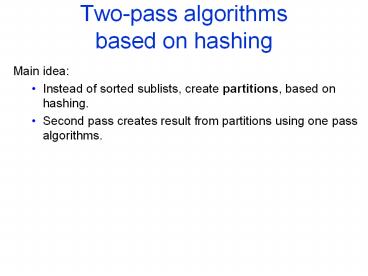Two-pass algorithms based on hashing PowerPoint PPT Presentation
1 / 10
Title: Two-pass algorithms based on hashing
1
Two-pass algorithms based on hashing
- Main idea
- Instead of sorted sublists, create partitions,
based on hashing. - Second pass creates result from partitions using
one pass algorithms.
2
Creating partitions
- Partitions (buckets) are created based on all
attributes of the relation except for grouping
and join, where the partitions are based on the
grouping and join-attributes respectively. - Why bucketize? Tuples with matching values end
up in the same bucket. - Initialize M-1 buckets using M-1 empty buffers
- FOR each block b of relation R DO
- read block b into the M-th buffer
- FOR each tuple t in b DO
- IF the buffer for bucket h(t) has no room for t
THEN - copy the buffer to disk
- initialize a new empty block in that buffer
- copy t to the buffer for bucket h(t)
- ENDIF
- ENDFOR
- FOR each bucket DO
- IF the buffer for this bucket is not empty THEN
- write the buffer to disk
3
Partition hash-join
- Pass 1 create partitions R1, ..,RM-1 of R, and
S1, ..,SM-1 of S, based on the join attributes
(the same hash function for both R and S) - Pass 2 for each pair Ri, Si
- compute Ri ?? Si
- using the one-pass method.
4
Example
- B(R) 1000 blocks
- B(S) 500 blocks
- Memory available 101 blocks
- R ?? S on common attribute C
- Pass 1 Use 100 buckets
- Read R
- Hash
- Write buckets
- Same for S, except partition size 5 blocks
5
- Pass 2
- Read one R bucket
- Build memory hash table
- Read corresponding S bucket block by block.
S
R
...
R
...
Memory
In general Cost 3(B(R) B(S)) Req.
min(B(R),B(S)) M2
- Cost
- Bucketize
- Read write R
- Read write S
- Join
- Read R
- Read S
- Total cost 31000500 4500
6
Hash-based duplicate elimination
- Pass 1 create partitions by hashing on all
attributes - Pass 2 for each partition, use the one-pass
method for duplicate elimination - Cost 3B(R) disk I/Os
- Requirement B(R) M(M-1)
- (B(R)/(M-1) is the approximate size of one
bucket) - i.e. the req. is approximately B(R) M2
7
Hash-based grouping and aggregation
- Pass 1 create partitions by hashing on grouping
attributes - Pass 2 for each partition, use one-pass method.
- Cost 3B(R), Requirement B(R) M2
- More exactly the requirement is
8
Hash-based set union
- Pass 1 create partitions R1,,RM-1 of R, and
S1,,SM-1 of S (with the same hash function) - Pass 2 for each pair Ri, Si compute Ri ? Si
using the one-pass method. - Cost 3(B(R) B(S))
- Requirement min(B(R),B(S)) M2
- Similar algorithms for intersection and
difference (set and bag versions)
9
Summary of hash-based methods
Operators Approx. M required Disk I/O
?, ? Sqrt(B) 3B
?, ?, - Sqrt(B(S)) 3(B(R)B(S))
?? Sqrt(B(S)) 3(B(R)B(S))
Assuming B(S) lt B(R)
10
Sort vs. Hash based algorithms
- Hash-based algorithms have a size requirement
that depends only on the smaller of the two
arguments rather than on the sum of the argument
sizes, as for sort-based algorithms. - Sort-based algorithms allow us to produce the
result in sorted order and take advantage of that
sort later. The result can be used in another
sort-based algorithm later. - Hash-based algorithms depend on the buckets being
of nearly equal size. Well, what about a join
with a very few values for the join attribute

